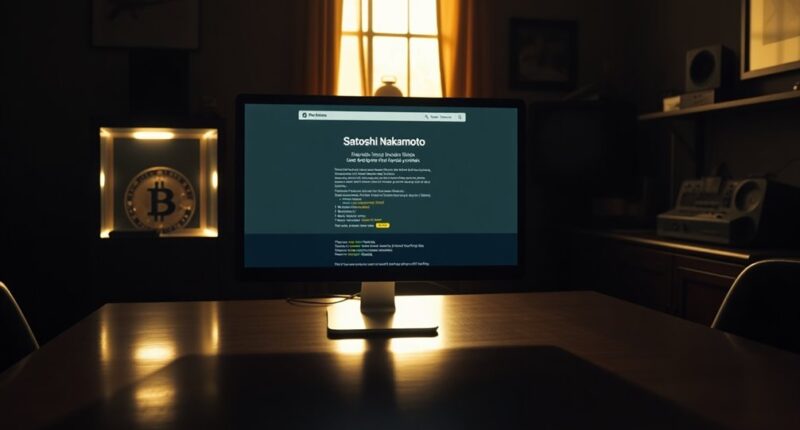You might find it intriguing to explore how Satoshi Nakamoto's first Bitcoin website, launched in 2008, laid the groundwork for the cryptocurrency movement. Initially, it was just a simple platform featuring the Bitcoin whitepaper, but it evolved significantly over time. This transformation reflects the values of decentralization and community engagement that continue to drive Bitcoin today. What insights can we uncover about its impact on the cryptocurrency landscape?

When Satoshi Nakamoto launched the first Bitcoin website shortly after registering the domain bitcoin.org on August 18, 2008, he set the stage for a revolutionary shift in the world of finance. This initial website was simplistic in design, reflecting the nascent stage of the project. It wasn't just a website; it was a platform that hosted the Bitcoin whitepaper, which outlined the technical specifications that would form the backbone of this pioneering digital currency.
By publishing the whitepaper on October 31, 2008, Nakamoto introduced a peer-to-peer electronic cash system that promised to disrupt traditional financial models. The website served as an educational tool, helping newcomers understand Bitcoin's potential. It promoted Bitcoin as an open-source project, inviting community involvement from the very beginning. You could engage with early adopters and developers through this platform, fostering discussions that would shape the future of cryptocurrency. It was a crucial starting point for a global movement.
After the Bitcoin network went live with the mining of the genesis block on January 3, 2009, and the initial software version was released on January 9, 2009, the website continued to play a pivotal role. The first Bitcoin transaction occurred on 24 May 2009, demonstrating the practical application of the system. Initially maintained by Satoshi and Martti Malmi, it became a repository for software updates and educational resources. When Nakamoto stepped back from the project, he ensured that Bitcoin's future remained decentralized by transferring domain ownership to others.
In 2013, the website underwent a redesign, featuring additional pages and tools that catered to an expanding audience. It evolved beyond its initial purpose, allowing community contributions that further strengthened the project. This transition illustrated the transformative power of collaboration, a principle deeply embedded in the ethos of open-source software.
The historical significance of that first Bitcoin website can't be overstated. It marks the genesis of the Bitcoin project and its lasting impact on financial technology. Even today, it stands as an important educational resource, nurturing new generations of Bitcoin enthusiasts and developers.
The legacy of this website is clear: it not only laid the groundwork for a decentralized financial system but also built a vibrant community dedicated to the principles of transparency and collaboration. As you explore the ongoing evolution of Bitcoin, remember that it all started with that first, unassuming website.









